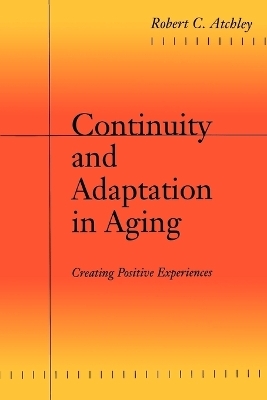
Continuity and Adaptation in Aging
Johns Hopkins University Press (Verlag)
978-0-8018-6632-6 (ISBN)
Drawing on data from a twenty-year longitudinal study that began with more than 1,200 individuals, Continuity and Adaptation in Aging explains one of the primary underlying forces that promotes effective adaptation to the aging process. This book will be of interest to researchers and students in gerontology and adult development.
Robert C. Atchley is a professor and chair of the Department of Gerontology at the Naropa Institute in Boulder, Colorado.
Contents: Preface Acknowledgments Continuity Theory How Did Continuity Theory Arise? Continuity Theory as Theory Elements of Continuity Theory Development versus Aging in Later Adulthood Case Examples Internal Continuity Continuity of the Self Self-Confidence Emotional Resilience Personal Goals Beliefs about the Effects of Retirement Summary External Continuity Living Arrangements, Household Composition,and Marital Status Income Adequacy Modes of Transportation Patterns of Activity: Stability, Continuity, and Change over Time How Activities Fit Together to Form Lifestyles Summary Adaptive Capacity Proactive Coping and Motivation for Continuity How Did Respondents Cope? Coping with Specific Changes: Retirement, Widowhood, and Functional Limitations Functional Limitation and the Self Patterns of Coping withFunctional Limitations General Patterns of Adaptation Factors Linked to Negative Outcomes in Later Life Summary Goals for Developmental Direction Continuity of Personal Goals Disposition toward Continuity Spiritual Development The Theory of Gerotranscendence The Study of Goals for Developmental Direction in Later Life Conclusion Assessing Continuity Theory Evidence on the Assumptions and Propositions of Continuity Theory Continuity Strategies Are Generally Effective Methodological Issues Related to the Study of Continuity Theory Future Research Using Continuity Theory Appendixes A. Tables B. The Ohio Longitudinal Study of Aging and Adaptation C. The 1995 Study Questionnaire D. Worksheets Used to Examine Longitudinal Patterns References Index
| Erscheint lt. Verlag | 26.2.2001 |
|---|---|
| Zusatzinfo | 2 Illustrations, black and white |
| Verlagsort | Baltimore, MD |
| Sprache | englisch |
| Maße | 152 x 229 mm |
| Gewicht | 390 g |
| Themenwelt | Geisteswissenschaften ► Psychologie |
| Studium ► 1. Studienabschnitt (Vorklinik) ► Histologie / Embryologie | |
| Sozialwissenschaften ► Soziologie | |
| ISBN-10 | 0-8018-6632-4 / 0801866324 |
| ISBN-13 | 978-0-8018-6632-6 / 9780801866326 |
| Zustand | Neuware |
| Haben Sie eine Frage zum Produkt? |
aus dem Bereich


